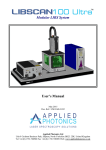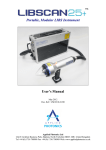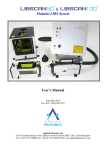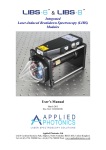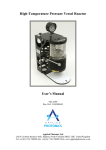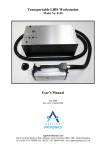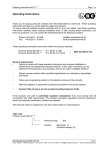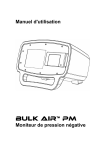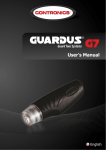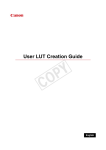Download LIBS Workstation™ User's Manual
Transcript
LIBS Workstation™ Model No. 0118 User’s Manual February 2007 Doc. Ref.: UM/0118/00 Applied Photonics Ltd Unit 8 Carleton Business Park, Skipton, North Yorkshire BD23 2DE, United Kingdom Tel +44 (0) 1756 708900 Fax +44 (0) 1756 708909 Web: www.appliedphotonics.co.uk Contents 1. Introduction Page 3 2. Safety 2.1 Laser radiation 2.2 Note on testing of laser safety window 2.3 Electrical 4 4 5 5 3. General description 3.1 Overview 3.2 The laser source 3.3 The articulated arm 3.4 The LIBS head 3.5 The geared column and rotary stage 3.6 The sample / experimental chamber 6 6 6 6 7 8 9 4. Operating procedure 11 5. Maintenance and inspection 13 Appendices A1 Certificate of Conformity © 2007 Applied Photonics Ltd 14 Page 2 of 14 1 Introduction The concept behind the LIBS Workstation™ was born out of desire to add to our laboratory facilities a highly adaptable LIBS instrument suitable for a wide range of research and development applications. Our laboratory and R&D requirements are such that we needed a LIBS instrument with the following capabilities and features: • • • • • • • • • • A modular design concept (laser source, LIBS head, sample chamber, etc) Co-axial laser transmission and plasma light collection optics Broad-band spectral response (180 – 900 nm) A compact and relatively light weight LIBS head (which essentially means that it does not contain the laser head) The ability to direct the laser beam at any angle between vertical and horizontal The ability to precisely adjust the focal plane of the laser beam An integrated low-power visible alignment laser The ability to select an appropriate laser and laser operating wavelength The ability to operate the LIBS head in stand-off mode (range up to several metres) A large and highly adaptable sample / experimental chamber offering full containment of the laser radiation (Class 1) and with provision for air / fume extraction From this “wish list”, the LIBS Workstation™ was born: Laser head support assembly Articulated arm launch module with integral 635 nm alignment laser Side entry port for LIBS head (fitted with flexible gaiter) Articulated arm (five degrees of freedom) Top entry port for LIBS head Air extract vent LIBS head Sample / experimental chamber Laser head Geared vertical column with rotary stage Laser safety window Air inlet filter port Mobile optical table Laser power supply unit General view of the LIBS Workstation™ © 2007 Applied Photonics Ltd Page 3 of 14 2 Safety 2.1 Laser radiation The LIBS Workstation™ is designed to be a research and development tool for use by organisations interested in conducting their own LIBS R&D program. It is imperative, therefore, that the LIBS Workstation™ is operated only by suitably trained and experienced persons who are fully aware of the hazards inherent to this type of high-power laser equipment. It is imperative also that, prior to using the equipment, an appropriate risk assessment is conducted in such a way as to take account of the proposed use of the equipment, the environment in which the equipment is to be operated, and how its use may affect people who are not directly involved with the use of the equipment. The LIBS Workstation may be configured in various ways by the user, including the use of an alternative laser source and/or alternative laser wavelength, pulse energy, pulse repetition rate, etc. For the purposes of this User’s Manual, it is assumed that the LIBS Workstation is fitted with a Q-switched Nd:YAG laser (Quantel Brilliant B) operating at its fundamental wavelength of 1064 nm, with maximum pulse energy of 850 mJ, pulse duration of nominally 5 ns and maximum repetition rate of 10 Hz (ie. max average power of 9 Watts). If any other laser and/or laser wavelength is to be used with the LIBS Workstation™, it is imperative that advice is sought from Applied Photonics Ltd on the suitability of the alternative laser and whether any modifications to the LIBS Workstation are necessary. Note that some of the images depicted in this User’s Manual show a laser source incorporating a 2nd harmonic generator (implying a laser wavelength 532 nm) – the 2nd harmonic generator was included in the images purely to replace another component which was not available for the photo shoot. The LIBS Workstation is designed to meet the laser safety requirements of the relevant European standards (BS EN 60825) and USA standards (ANSI Z136.1 – 2000). Although the LIBS Workstation is supplied with a sample chamber which provides adequate containment of the laser radiation, it is possible for the user to operate the LIBS Workstation without the sample chamber (ie. operation in “open beam” mode as may be required for certain types of experiment). Accordingly, it is necessary to consider the LIBS Workstation as a Class 4 laser product and so, by definition, the equipment poses a risk of personal injury (eye, skin injury) and poses a fire risk. As with all Class 4 laser products, appropriate safety precautions must be taken as identified via a suitable risk assessment conducted by the user in consultation with a suitably qualified and experienced Laser Safety Officer. It is imperative that the LIBS Workstation is operated only by suitably qualified and experienced personnel who are fully aware of the potential hazards associated with the use of this type of high-power laser equipment. The most significant hazard relating to exposure of personnel to the laser radiation is eye injury since direct or scattered laser radiation produced by the LIBS Workstation can cause serious and permanent damage to the eyes including blindness - such damage may be instantaneous. Precautions must be taken to avoid exposure of personnel to hazardous levels of laser radiation. Such precautions may include the setting up of a temporary or permanent controlled area. Other measures may also be necessary, as determined by appropriate and thorough assessment of the risks (ie. a risk assessment) conducted by the personnel responsible for the safe use of the LIBS Workstation. Consult the manual supplied with the laser for further guidance on the safe use of the laser. The door of the sample chamber is equipped with an electrical interlock switch which is designed to prevent activation of the laser unless the door is closed. The interlock switch connects to the laser power supply using a length of BNC-to-BNC cable which is supplied with the LIBS Workstation. The cable connects to the BNC port at the top rear of the sample / experimental chamber and to the interlock BNC port on the front panel of the Quantel laser power supply. © 2007 Applied Photonics Ltd Page 4 of 14 IMPORTANT 2.2 • NEVER allow unauthorised and/or untrained personnel operate the LIBS Workstation. • ALWAYS use appropriate laser safety protective eyewear when operating the LIBS Workstation in “open-beam” configuration – you should seek advice from your Laser Safety Officer on this matter. • ALWAYS switch the instrument off when not in use and remove the key from the keyswitch of the laser power supply to prevent unauthorised activation. • NEVER operate the LIBS instrument in areas where explosive gas mixtures may be present. • NEVER place inside the sample chamber flammable liquids or any other material which may give rise to flammable / explosive gas mixtures. Activation of the laser under these conditions could result in an explosion leading to severe personal injury and/or fire hazard. • ALWAYS thoroughly inspect the LIBS Workstation for damage prior to use. Particular attention should be given to the laser safety window and electrical safety interlocks fitted to the door of the sample chamber. • NEVER point the LIBS head at a person (even with laser switched off), especially towards the eyes, even if the person is wearing laser safety eyewear. The laser should be considered “active” unless the laser power supply is deactivated and the safety shutter fitted to the laser head is switched to the OFF position. Note on testing of the laser safety window The laser safety window material is rated at OD 6+ @ 1064 nm. It therefore provides adequate protection against scattered laser light of wavelength 1064 nm. It provides no protection at other laser wavelengths and so it is the responsibility of the user of the LIBS Workstation to ensure that it is appropriate for the type of laser being used with the LIBS Workstation. Applied Photonics Ltd have carried out tests on the performance of the laser safety window when exposed to laser radiation from a Q-switched Nd:YAG laser (Quantel Brilliant B, 850 mJ, 5 ns pulse length, 10 Hz pulse repetition frequency). The tests were conducted in accordance with European standard BS EN 207:1999. The test essentially consists of exposing the window to a fluence of at least 0.5 J cm-2 for at least 100 laser pulses. The results of the tests concluded that the window material is able to safely attenuate the laser radiation by at least a factor of 106. 2.3 Electrical The laser head and laser power supply of the LIBS Workstation contain electrical circuits operating at potentially lethal voltage and current levels. Before removing any access covers, isolate mains power from the laser and depress the capacitor discharge switch located at the rear of the laser power supply. Consult the manual supplied with the laser for further guidance on the safe use of the laser. Two fluorescent lights (36 Watts total) are fitted to the inside of the sample chamber to provide illumination. These lights are of the automotive type, ie. they require a 12 VDC electrical supply. The LIBS Workstation is supplied with a mains adapter which provides 12 VDC (5 Amp max.) from either a 110 VAC or 230 VAC (50-60 Hz) source. The mains adapter is of the SELV type and so does not present an electric shock hazard. The lead from the mains adapter connects to an electrical socket located at the top rear of the sample chamber. The polarity of the socket is centre pin positive. © 2007 Applied Photonics Ltd Page 5 of 14 3 General description 3.1 Overview A general view of the LIBS Workstation is given in figure 1 on page 3 of this User’s Manual. The LIBS head contains the optics used to focus the laser beam onto a target sample and to collect plasma light from the laser-induced plasma. The focal plane of the laser beam may be adjusted manually by the user. The LIBS head is connected to the laser via an articulated arm of length approx. 1.5 metres and having 5 degrees of freedom. The articulated arm is used to transmit the laser beam to the LIBS head while allowing a high degree of freedom of movement of the LIBS head. This allows the user to direct the laser beam emitted from the LIBS head in any desired direction and at any position within the reach of the articulated arm (approx. 1.5 metres). The geared column and rotary stage are used to adjust the height of the LIBS head above the optical table and to allow rotation of the LIBS head so that the laser beam may be directed at any angle between horizontal and vertical. Once the correct height and orientation of the LIBS head has been achieved, the geared column and rotary stage may each be locked off so that the position of the LIBS head is maintained. The LIBS Workstation may be used in “open beam” mode by directing the laser beam emitted from the LIBS head to the sample material to be analysed. Alternatively, the sample chamber may be used (as depicted in the following figure) in order to provide containment of the laser radiation for increased safety of the user. The sample chamber is equipped with two side ports and one top port, each designed to accommodate the LIBS head. A flexible gaiter may be used with the side ports (as illustrated in the following figure) allowing the user to adjust the angle of the laser beam incident on a sample located inside the chamber. 3.2 The laser source The LIBS Workstation may be supplied with various laser sources or may be designed to accommodate an existing laser at the user’s facility. If you require us to supply the LIBS Workstation with a preinstalled laser, we recommend the Quantel Brilliant B laser which offers high pulse energy (up to 850 mJ @ 1064 nm) from a relatively compact device. This laser is also easily configured for alternative (harmonic) wavelengths by simply adding the appropriate module(s) to the laser head. 3.3 The articulated arm The articulated arm and associated launch module are shown in the following images. The arm consists of an input and output flange, two tubes (50 mm OD, ~550 mm length) and five rotating “knuckle joints” each of which contains a high-energy, dual-wavelength YAG mirror. Each mirror is mounted in a precision-engineered aluminium alloy housing with three micro-positioner screws for angular adjustment of the mirror. The two tubes are of length ~550 mm which gives the arm a reach of approaching ~1.1 metre. Launch module Flexible gaiter port Articulated arm View of LIBS Workstation illustrating the articulated arm and launch module © 2007 Applied Photonics Ltd Page 6 of 14 The launch module contains the optics required to launch the Nd:YAG laser beam and the visible alignment laser beam into the articulated arm. The optics in the launch module and the mirrors in the articulated arm are precisely aligned during installation of the laser. It is strongly recommended that the user does not make adjustments to any of these components as special tools and methods are required for correct alignment of the laser beams. 3.4 The LIBS head The LIBS head contains the optics required to focus the laser beam and to collect the plasma light for transmission to an optical spectrograph. The articulated arm connects to the LIBS head via the arm output flange. A removable beam tube is fitted to the output aperture of the LIBS head. An SMA connector (located on the underside of the LIBS head) is used to provide fiber-optic connection to the optical spectrograph (not shown). View of one possible configuration of the LIBS Workstation without the use of the sample chamber A two-lens (1” diameter) beam expander is used to adjust the focal plane of the laser beam. The separation of the lens-pair may be adjusted by rotating the knob located on the left side of the LIBS head (see image above). Clock-wise rotation of the focus knob increases the distance to the focal plane, and vice-versa. With the lens-pair supplied with the LIBS Workstation, the focal plane may be adjusted between approximately 300 mm and 2000 mm as measured from the side panel of the LIBS head (ie. excluding the beam tube). The laser beam passes through a 2” diameter pierced mirror which is located immediately down-stream of the beam expander and tilted at 45 degrees with respect to the axis of the laser beam (see following image). A second lens-pair (2” diameter) is used to image the plasma light onto the plane of the SMA connector. The position of the SMA connector may be adjusted in the X, Y © 2007 Applied Photonics Ltd Page 7 of 14 and Z directions. For a given experiment, the position of the SMA connector should be adjusted to provide optimum transmission of plasma light to the spectrograph. Inside view of LIBS head 3.5 The geared vertical column and rotary stage The geared column allows the LIBS head to be raised and lowered in a vertical direction above the optical table. The geared column is fitted with a rotary stage which allows the LIBS head to be rotated about the axis of the stage, allowing the laser beam to be directed at any required angle. Geared vertical column Locking nut for vertical column Handle for vertical column stage Attachment bracket for LIBS head Handle for rotary stage head Vernier scale displaying angle Front view of rotary stage © 2007 Applied Photonics Ltd Page 8 of 14 Locking nut for vertical column Handle for raising / lowering vertical column stage Handle for rotary stage Locking screw for rotary stage Rear view of geared column / rotary stage with LIBS head attached 3.6 The sample / experimental chamber The main features of the sample / experimental chamber are illustrated in the following figures. Electrical connections for door interlock switch and internal lighting (sockets at rear) Top entry port for LIBS head Air extract port (integral HEPA filter) Cable entry port (not in view) Upper side entry port for LIBS head Laser safety window (OD 6+ @ 1064 nm) Lower side entry port for LIBS head (fitted with inlet air filter cover plate) View of sample chamber illustrating main components © 2007 Applied Photonics Ltd Page 9 of 14 Door interlock switch Air extract port fitted with internal light baffle plate Beam tube of LIBS head (LIBS head fitted to top port) Cable entry port fitted with internal light baffle plate Lower side port fitted with air inlet filter and light baffle plate Optical breadboards (M6 tapped blind holes on 25 mm centres Inside view of sample chamber with LIBS head fitted to top entry port (beam tube can be seen entering the chamber from the top) A flexible gaiter may be fitted to either of the side entry ports, the purpose of which is to allow the user to direct the laser beam into the sample chamber at various angles between horizontal and approximately 45 degrees from the vertical whilst maintaining containment of the laser radiation. This feature allows LIBS experiments to be conducted with the laser beam impinging the sample at various angles. This is particularly useful when conducting LIBS analysis of liquids. Flexible gaiter for attachment to side entry port. The beam tube of the LIBS head is designed to slide into the flexible gaiter. Beam tube of LIBS head View of sample chamber fitted with flexible gaiter port © 2007 Applied Photonics Ltd Page 10 of 14 View of sample chamber with laser beam impinging sample at an angle of ~45 degrees 4 Operating procedure The operating procedure is governed primarily by the operation of the laser and the spectrograph, instructions for which are provided by the manufacturer of each device. The electrical connection between the sample chamber door interlock switch and the laser power supply must be made before activating the laser. The LIBS Workstation is supplied with a BNC-to-BNC cable of approximately 2 metres length for this purpose. Connection to the laser power supply should be as instructed by the laser manufacturer (see documentation supplied with laser). Correct operation of the door interlock should be checked out before using the LIBS Workstation. The LIBS head may be used in various ways, as illustrated in the following images. The method of attachment is illustrated in the images and is largely self-explanatory. Care should be exercised in the manual handling of the LIBS head and articulated arm as each contains sensitive optical components. Excessive shock / vibration may result in misalignment of the optical components. If this is suspected, the LIBS Workstation should be immediately taken out of service and advice sought from the manufacturer as to what remedial action may be required. Views of LIBS Workstation illustrating various possible configurations of LIBS head with the sample chamber © 2007 Applied Photonics Ltd Page 11 of 14 Views of LIBS Workstation illustrating various possible configurations of LIBS head without the sample chamber Correct focus of the laser beam is achieved by adjusting the focus control knob on the LIBS head. It will be necessary to adjust the fibre-optic SMA connector in the X, Y and Z directions in order to achieve optimum transmission of plasma light to the spectrograph. This is best achieved by conducting a “dummy run” LIBS experiment using a piece of steel as a sample target and operating the spectrograph in “free run” mode. The X, Y and Z position of the fibre-optic SMA connector port should then be adjusted to maximise the recorded spectral intensity. Warning – depending upon the nature of the experimental conditions, there is a risk of emission of dangerous levels of laser radiation from the SMA connector port. It is recommended, therefore, that the user of the LIBS Workstation wears appropriate eye protection whenever making adjustments to the SMA connector port or when operating the LIBS Workstation without the fibreoptic cable connected to both the SMA connector port and the spectrograph. Image of SMA positioner © 2007 Applied Photonics Ltd Image of SMA positioner fitted to port of LIBS head Page 12 of 14 Blanking covers are provided with the LIBS Workstation for fitting to unused side entry ports or the top entry port. It is important that these blanking ports are used to ensure the sample chamber provides adequate containment of the laser radiation. One of the side entry port blanking covers is fitted with a filtered air inlet port to allow air to enter the sample chamber when air extraction is utilized. The LIBS Workstation is equipped with a cable entry port on the right hand side panel of the sample chamber (as illustrated in the following figure). The cable entry port is designed to allow cables to be fed into the sample chamber without compromising the containment of the laser radiation. To install a cable, it is necessary to first remove the outer cover plate and the internal light baffle plate. Cables are fed into the cable entry port from below, pass through the rubber barrier and then back down the inside of the port behind the internal light baffle plate – examination of the cable entry port with the outer cover removed should make this procedure self-explanatory. Cable entry port Cables are fed up into the port via the opening in the lower face of the cover plate View of right hand side of sample chamber showing cable entry port 5 Maintenance and inspection The LIBS Workstation should be periodically inspected for signs of damage or wear and tear. Of particular importance are the safety features including the laser safety window and the door interlock switch mechanism. If any damage to the laser window material is observed or suspected, the LIBS Workstation should be temporarily removed from service until a replacement window is fitted. The inlet air filter and the outlet air HEPA filter should be inspected at least yearly and replaced if necessary. Replacement parts are available from the manufacturer. © 2007 Applied Photonics Ltd Page 13 of 14 Appendix A1 Certificate of Conformity Applied Photonics Limited Unit 8 Carleton Business Park Skipton North Yorkshire BD23 2DE United Kingdom EC Declaration of Conformity Applied Photonics Ltd declares that the product listed below has been designed and manufactured in compliance with the relevant standards as follows: Product name: LIBS Workstation™ Model Number: 0118 Laser product safety This device conforms with the principal objectives of safety of laser products by application of the following standards: BS EN 60825-14:2004 and BS EN 207:1999 Electrical Safety This device conforms with the principal safety objectives of the European Directive 73/23/EEC, as implemented by the Electrical Equipment (Safety) Regulations 1994, by application of the following standard: BS EN 61010-1:2001. Electro-Magnetic Compatibility This device conforms with the principal objectives of the European Directive (89/336/EEC) as amended by 91/31/EEC and 93/68/EEC, as implemented by The EMC Regulations (SI 1992 No. 2372 and amendment SI 1994 No. 3080), by application of the following standard: BS EN 61326-1:1997 Year of affixation of the CE Marking: 2007 Signed: Name: Andrew I. Whitehouse Title: Managing Director Place: Applied Photonics Ltd, Unit 8 Carleton Business Park, Skipton, North Yorkshire BD23 2DE, United Kingdom Date: 15 February 2007 © 2007 Applied Photonics Ltd Page 14 of 14















